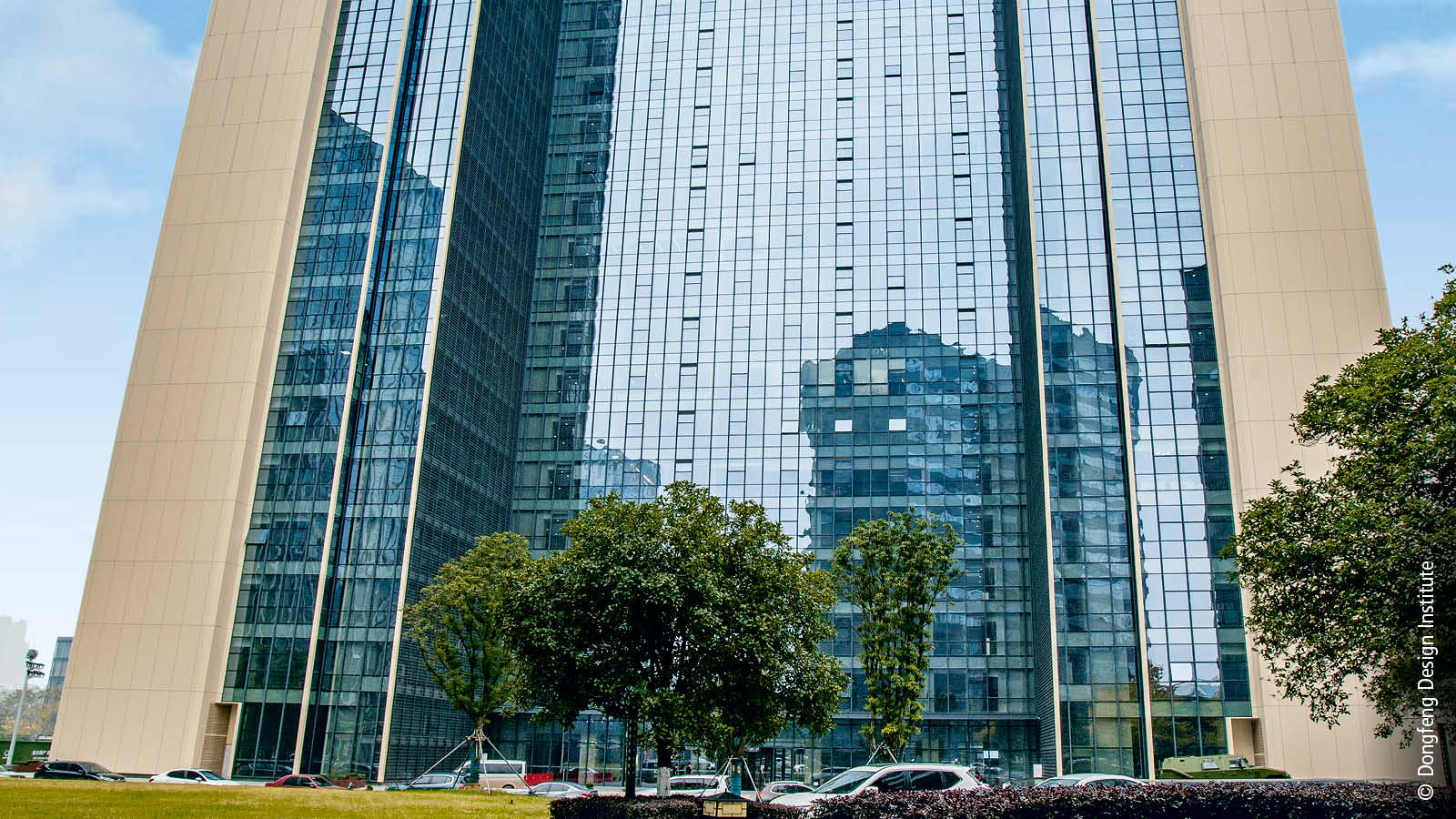
Fully automated building operation enables significant energy savings
Fully automated building operation enables significant energy savings
PC-based building automation helps to create digital twins
Building H in Wuhan was designed with green buildings in mind from the outset. The open control technology from Beckhoff made it easy to integrate all equipment into the building management system developed by Dongfeng Design Institute. A digital building twin now provides capabilities for self-diagnostics, self-analysis and even autonomous decision-making.
Building H is a landmark building in the Wuhan Economic and Technological Development Zone (WEDZ) with a floor area of 82,000 m2. With its H-shaped design, it maximizes the use of natural light for illumination. A photovoltaic power station built on the roof provides an annual energy generation capacity of over 200,000 kWh, which basically corresponds to the annual electricity consumption of the building's lighting. A rainwater collection device with a volume of 300 m3 on the roof provides recycled water for cleaning the building and watering the plants, to minimize the consumption of fresh water and energy. All this equipment is connected to the control system from Beckhoff to ensure reliable operation.
The project was implemented by high-tech enterprise Dongfeng Design Institute, which is driving digitalization in the fields of BIM (Building Information Modeling), the digital factory, intelligent buildings etc. The aim was to implement a smart building that would satisfy the requirements of the whole industrial value chain and enable the application of building management functions across the full life cycle. Building H is also considered a benchmark project for the use of a digital building twin in Wuhan.
The smart building management system incorporates various sub-systems such as building automation, energy management, facility management, fire protection, access security and environmental monitoring. All these are combined through the "DFD intelligent building operation and maintenance management platform" developed by Dongfeng Design Institute. It realizes a digital twin system through mutual mapping and bidirectional control between the real physical environment and the virtual digital space, which provides the building with capabilities for self-diagnostics, self-analysis and even autonomous decision-making within the framework set by the facility management. The overall aim is to optimize the building’s operation in order to achieve a harmonious coexistence of human beings, building and nature – in line with the Chinese national strategy of achieving peak carbon dioxide emissions by 2030 and carbon neutrality by 2060.

The H-shaped building is designed to let in a maximum of natural light and, through a digital building twin, has abilities for self-diagnostics, self-analysis and autonomous decision-making.
A model in the field of building automation
There is no single wall switch for controlling the lighting for the public zones in the building. All the lights are controlled automatically through a control system from Beckhoff, which on the hardware side consists of CX9020 Embedded PCs – also certified as BACnet Building Controllers – BK9050 Bus Couplers for Ethernet TCP/IP communication and diverse Bus Terminals. The star topology is easy to network and convenient for management and maintenance purposes. The control system also supports the latest DALI 2 lighting technology and KNX for infrared human presence sensors, which significantly simplifies wiring. TwinCAT automation software from Beckhoff facilitates the engineering process.
Different types of presence sensors are used depending on the building areas, with frequent movement of persons in the public areas and usually less frequent movement of persons in the office areas, especially the independent offices, therefore they have different requirements regarding detectors. The seamless integration of all detectors into the control platform is the basis for needs-based resource utilization and the avoidance of energy waste. Combined with the continuous evolution of intelligent control algorithms this has resulted, for example, in lighting energy savings of more than 40% over two years of operation. In this way, tangible benefits could also be achieved in air conditioning. "The building uses a VRV (Variable Refrigerant Volume) air conditioning system, which is connected to the Beckhoff control platform via the BACnet fieldbus for simple wiring and easy maintenance. Combined with the algorithm for human presence detection, the HVAC energy savings rate exceeds 20%," says Ke Zhenyu, project implementation manager for Building H. The entire building operation and maintenance system is based on the open automation platform from Beckhoff and bus standards used worldwide, which makes the building not only modern but also leaves space for future expansion.
Digital twin for buildings
The life cycle of a building is usually at least 20 to 30 years, or even longer. In the past, buildings without an information-based platform would encounter various problems after several years of operation due to poor management. BIM, on the other hand, enables data-driven management during the whole life cycle of a building. In addition, a BAS (Building Automation Management System) provides a platform for monitoring all mechanical and electrical equipment in the building. Thus, through the combination of BIM and BAS, the data is mapped in the virtual space and the platform reflects the current status of all systems over the entire life cycle of the real building, which is a major evolution from traditional information and automation technology to the digital twin.
Through the high connectivity of PC-based control, Beckhoff provides the ideal solution for bridging the gap between IT and automation, according to Ke Zhenyu. The reason is that the highly integrated and open automation platform helps users implement the interfaces for accessing the monitoring and control data of all equipment in the building within a very short period of time. It also assists in structuring a platform for the digital twin of the building, greatly reducing investments as well as construction time and costs. According to Dongfeng, this is one of the most important reasons why users should choose Beckhoff.
A pioneering project
After visiting Building H, leaders and experts from well-known organizations in Wuhan from the construction, architecture and research sectors praised Wuhan Dongfeng Design Institute for its unique concept and said that many advanced ideas had been put into practice with promising results. Building H, they said, represents the latest state of the art in the intelligent building industry and sets a new direction for future development.
Beckhoff source
